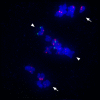Inna Golubovskaya: the life of a geneticist studying meiosis
- PMID: 21742729
- PMCID: PMC3176548
- DOI: 10.1534/genetics.111.130039
Inna Golubovskaya: the life of a geneticist studying meiosis
Abstract
Maize, with its excellent forward genetics and male sterility screens, was used to identify >50 meiotic mutants representing at least 35 genes that affect key prophase processes such as pairing, synapsis, and homologous recombination. Most of these mutants were found by Inna Golubovskaya during the course of her remarkable career as a cytogeneticist. In addition to undertaking general cytological surveys to classify mutant phenotypes, Golubovskaya focused her efforts on characterizing several key regulatory mutants: ameiotic1 (am1), required to establish the meiotic cell cycle in maize; absence of first division (afd1), required for proper prophase chromosome morphology and for meiotic sister-chromatid cohesion leading to a reductive chromosome segregation at the first meiotic division; and plural abnormalities of meiosis (pam1), required for the clustering of telomeres on the nuclear envelope needed for pairing and synapsis. Her dramatic childhood in Leningrad during its siege in World War II, her fortuitous education in genetics at Leningrad State University, her continued research at the forward-looking Institute of Cytology and Genetics of the USSR Academy of Science Siberian branch, her plight at the fall of the Soviet Union, and her work in America helped engender a unique and valuable plant geneticist. Inna Golubovskaya related this personal history to the authors in conversation.
Figures



Similar articles
-
The role of the ameiotic1 gene in the initiation of meiosis and in subsequent meiotic events in maize.Genetics. 1993 Dec;135(4):1151-66. doi: 10.1093/genetics/135.4.1151. Genetics. 1993. PMID: 8307330 Free PMC article.
-
The pam1 gene is required for meiotic bouquet formation and efficient homologous synapsis in maize (Zea mays L.).Genetics. 2002 Dec;162(4):1979-93. doi: 10.1093/genetics/162.4.1979. Genetics. 2002. PMID: 12524364 Free PMC article.
-
The maize (Zea mays) desynaptic (dy) mutation defines a pathway for meiotic chromosome segregation, linking nuclear morphology, telomere distribution and synapsis.J Cell Sci. 2012 Aug 1;125(Pt 15):3681-90. doi: 10.1242/jcs.108290. Epub 2012 May 2. J Cell Sci. 2012. PMID: 22553213
-
The cytogenetics of homologous chromosome pairing in meiosis in plants.Cytogenet Genome Res. 2008;120(3-4):313-9. doi: 10.1159/000121080. Epub 2008 May 23. Cytogenet Genome Res. 2008. PMID: 18504360 Review.
-
Genetics of meiotic prophase I in plants.Annu Rev Plant Biol. 2006;57:267-302. doi: 10.1146/annurev.arplant.57.032905.105255. Annu Rev Plant Biol. 2006. PMID: 16669763 Review.
Cited by
-
Radiation hybrid QTL mapping of Tdes2 involved in the first meiotic division of wheat.Theor Appl Genet. 2013 Aug;126(8):1977-90. doi: 10.1007/s00122-013-2111-z. Epub 2013 May 29. Theor Appl Genet. 2013. PMID: 23715938
-
A Phosphoproteomics Study of the Soybean root necrosis 1 Mutant Revealed Type II Metacaspases Involved in Cell Death Pathway.Front Plant Sci. 2022 Jul 19;13:882561. doi: 10.3389/fpls.2022.882561. eCollection 2022. Front Plant Sci. 2022. PMID: 35928708 Free PMC article.
-
The Maize Divergent spindle-1 (dv1) Gene Encodes a Kinesin-14A Motor Protein Required for Meiotic Spindle Pole Organization.Front Plant Sci. 2016 Aug 25;7:1277. doi: 10.3389/fpls.2016.01277. eCollection 2016. Front Plant Sci. 2016. PMID: 27610117 Free PMC article.
-
Mapping of QTL for kernel abortion caused by in vivo haploid induction in maize (Zea mays L.).PLoS One. 2020 Feb 5;15(2):e0228411. doi: 10.1371/journal.pone.0228411. eCollection 2020. PLoS One. 2020. PMID: 32023320 Free PMC article.
-
Identification and Map-Based Cloning of the Light-Induced Lesion Mimic Mutant 1 (LIL1) Gene in Rice.Front Plant Sci. 2017 Dec 19;8:2122. doi: 10.3389/fpls.2017.02122. eCollection 2017. Front Plant Sci. 2017. PMID: 29312386 Free PMC article.
References
-
- Abramova L. I., Avalkina N. A., Golubeva E. A., Pyzhenkova Z. S., Golubovskaya I. N., 2002. Embryological effect of the mac1 mutation in Zea Mays (Poacaae). Bot. J. (Russ) 87: 28–32
-
- Beadle G., 1929. A gene for supernumerary mitosis during spore development in Zea mays. Science 50: 406–407 - PubMed
-
- Beadle G. W., 1930. Genetic and cytological studies of a Mendelian asynaptic in Zea mays. Cornell Agric. Exp. Sta. Mem. 129: 1–23
-
- Beadle G. W., 1931. A gene in maize for supernumerary cell divisions following meiosis. Cornell Univ. Agr. Exp. Sta. Mem. 135: 1–12
Publication types
MeSH terms
Personal name as subject
- Actions
LinkOut - more resources
Full Text Sources
Other Literature Sources

